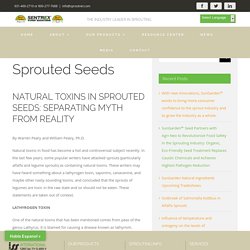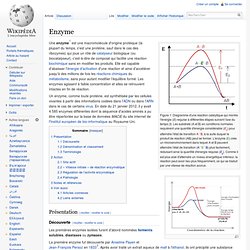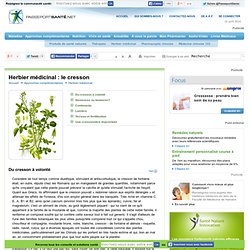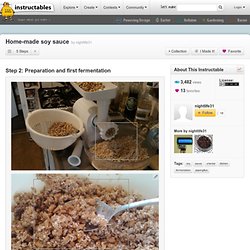

Natural Toxins in Sprouted Seeds - International Specialty Supply. By Warren Peary and William Peavy, Ph.D.

Natural toxins in food has become a hot and controversial subject recently. In the last few years, some popular writers have attacked sprouts (particularly alfalfa and legume sprouts) as containing natural toxins. These writers may have heard something about a lathyrogen toxin, saponins, canavanine, and maybe other nasty-sounding toxins, and concluded that the sprouts of legumes are toxic in the raw state and so should not be eaten. These statements are taken out of context. One of the natural toxins that has been mentioned comes from peas of the genus Lathyrus. Non-edible peas of the genus Lathyrus include sweet peas, which are ornamentals grown for their scented flowers.
Outbreaks of lathyrism in India have been blamed on eating large amounts of the non-edible chickpea without proper cooking. There are at least 1,500 species of legumes within one of three subfamilies of the family Leguminosae (Latin for legume). Part II. MUSHROOM CULTIVATION BY PEOPLE WITH DISABILITIES - A guide. Introduction Introduction to mushroom cultivation Step 1.

ABOUT MUSHROOMS Step 2. PRODUCING PDA MEDIUM Step 4. MULTIPLYING SPAWN ON SORGHUM SEEDS Step 5. PRODUCING SUBSTRATE BAGS Step 6. PASTEURIZING BAGS Step 7. Introduction Mushrooms can be found in forests around the world. This guide is an introduction to mushroom cultivation and will give basic knowledge and techniques required in mushroom cultivation. Introduction to mushroom cultivation Mushroom cultivation can be summarized with the following major steps: Jihyun Ryou - a Korean artist about her storage solution for vegetables. Nutrient Database for Standard Reference, Release 18. Medorth. Graines germées, jeunes pousses Vous pouvez donc faire germer :

Manger des graines germées: l'exemple du blé (Page 1) / L'alimentation en randonnée légère. Edit: j'ai modifié le titre 'germination epeautre lentille soja" en "Manger des graines germées: l'exemple du blé" Bonjour,

It's Time to Forage with Google Maps. If you live in the northern hemisphere then the time and fruit is ripe to put on your foraging cap.

I've been picking and cooking & baking with this year's blackberry crop for about a month now. If you want to know where you can find your nearest fruit trees and edible plants then these Google Maps should be able to help: Urban Edibles - This crowdsourced map can help you find wild food sources in Portland, Oregon. Concrete Jungle - Your Google Maps based guide to wild food sources in the Atlanta area. Boise’s Urban Foods Map - If you live in Boise then consult this Google Map to find your nearest foraging locations. Neighborhoodfruit is a crowdsourced map of fruit trees on public land in the U.S.. Forage.rs is a collaborative map of edible and useful wild plants worldwide.
Urban Edibles - a collaborative map of wild edible plants and fruits in Amsterdam. Le mode de vie macrobiotique. Forage.rs Wild Edibles Collective Map. Enzyme. Un article de Wikipédia, l'encyclopédie libre.

Figure 1: Diagramme d'une réaction catalytique qui montre l'énergie (E) requise à différentes étapes suivant l'axe du temps (t). Les substrats (A et B) en conditions normales requièrent une quantité d'énergie considérable (E1) pour atteindre l'état de transition A...B, à la suite duquel le produit de réaction (AB) peut se former. Cultures/Enzymes. Culture ferments enzymes probiotiques fermentation fromages produits laitiers suppléments alimentaire Enzymes. Make Tempeh yourself. Cresson. Du cresson à volonté Considéré de tout temps comme diurétique, stimulant et antiscorbutique, le cresson de fontaine était, en outre, réputé chez les Romains qui en mangeaient de grandes quantités, notamment parce qu'ils croyaient que cette plante pouvait prévenir la calvitie et qu'elle stimulait l'activité de l'esprit.

Quant aux Grecs, ils affirmaient que le cresson pouvait « redonner raison aux esprits dérangés » et atténuer les effets de l'ivresse, d'où son emploi général dans les banquets. Fruit Beer. The coldroom.com Beta Home. How soy sauce is made - making, history, used, processing, parts, components, steps, product, industry, History, Raw Materials, The Manufacturing Process, Quality Control, Byproducts/Waste. Background Soy sauce is one of the world's oldest condiments and has been used in China for more than 2,500 years.

It is made from fermenting a mixture of mashed soybeans, salt, and enzymes. It is also made artificially through a chemical process known as acid hydrolysis. History The prehistoric people of Asia preserved meat and fish by packing them in salt. Soy Cultures. Preparation and first fermentation. For the preparation of the soy sauce I used several sources, including the recipes the came with the soy cultures I ordered from Gemcultures.

As I want to find a recipe for a good soy sauce, I included many different variations in this first try. Chinese soy sauce is made by fermentation of mostly soy beans, while for Japanese soy sauce equal amount of soy and wheat is used. For extra flavour, the wheat is sometimes roasted as well. I therefore roasted a part of the soy beans in a coffee bean roaster to 190C for several minutes. Tempeh.